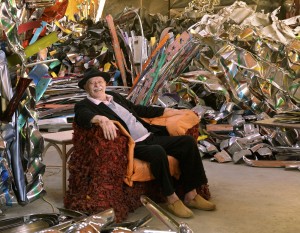The Art of Fender-Bending: John Chamberlain at the Guggenheim
In a car-obsessed culture, everyone’s got another crash, another pile-up story to beat all. In sculptor John Chamberlain’s case, his fender-benders were no accident. The metal parts may be found just about anywhere, but the magnificently mangled end results are all his.
A major retrospective of almost 100 works by the Solomon R. Guggenheim Museum in New York entitled John Chamberlain: Choices is putting this controversial, always fascinating, artist’s 60-year career front and center for the public.
“One day something—some one thing—pops out at you,” he has stated, “and you pick it up, and you take it over, and you put it somewhere else, and it fits.”
According to senior curator, Susan Davidson, that process of active selection, of choice and fit, was the guiding principle of Chamberlain’s life.
Everywhere one ascends or descends the dizzying, spiral ramps that rise from the Guggenheim’s central rotunda, this wildly colorful array of crushed and compressed shapes are a feast for the eyes. As intriguing as each assemblage of fenders and bumpers and hoods and other miscellaneous welded parts may be, it’s often the spray painted, sand-blasted, dripping explosions of color that catch one’s attention. For the formalists who derided the use of color in sculpture, Chamberlain’s approach was downright mutinous.
In large-scale works like Lord Suckfist (1989) and The Devil and The Deep Blue Sea (1983) one confronts, in the first, a tall, scrappy, alien-like being from another world—one far more flashy and whimsical than our own. In the latter grouping, the viewer’s on his own to find the devil in the sculptor’s details. The huddled line-up resembles more of a nonsensical pop version of Rodin’s The Burghers of Calais. Another of many show-stoppers is a compressed bundle entitled Opera Chocolates. This chrome-painted, steel sculpture does indeed resemble a crushed candy wrapper.
Not all of Chamberlain’s titles fit the mold so aptly. He often shuffled index cards, mixing and matching words for his creations. An early stint at the avant-garde Black Mountain College of North Carolina—where he credited faculty poets like Robert Creeley, Robert Duncan and Charles Olson as early influences; his deconstructionist, dada-like use of language stayed with him throughout his career.
Chamberlain’s epiphany about the possibilities of junk metal happened in 1957, while he was staying with his abstract expressionist pal, Larry Rivers. He pulled two fenders from a 1929 Ford rusting on the artist’s property. Then he ran a truck over the pieces until he was satisfied with the “fit.” The result was a steel and iron piece called Shortstop that any Star Wars enthusiast would love.
“John was in the middle of everything and the center of nothing,” senior curator, Davidson remarked. Born in Rochester, Indiana in 1927, he left school in the ninth grade, joined the navy in 1943, and returned to Chicago to study hairdressing on the G.I. Bill—an occupation he saw as a good way to meet women. After a year at the School of the Art Institute of Chicago, and an eye-opening stay at Black Mountain College, New York awaited his arrival.
“John arrived at a very vibrant time for American artists,” Davidson said.
But every attempt to place him in conflicting categories with the Abstract-Expressionist, Pop, and Minimalist wunderkinds of the day failed. His work defied, and continues to defy, convenient description.
Chamberlain’s curiosity was hardly limited to automobile parts. In the mid-60s, he produced highly-glossed, small-format square pictures, using enamel automobile finish with startlingly fresh results. Fueled by an interest in science, he experimented with urethane foam, aluminum foil, and paper bags. Luna, Luna, Luna (in memory of Elaine Chamberlain) is one of the most elegant constructions in the show. Fashioned in mineral-coated polymer resin, its transparency seems to suggest the evanescence of life itself.
Chamberlain even took a detour into filmmaking, with a cult hit, The Secret Life of Hernando Cortes, filmed in Mexico with Warhol regulars such as Ultra Violet.
Fortunately, for his most ardent fans, he returned to the metal constructions, to the bumpers and chassis of cars that had first captured his heart. A larger studio in Sarasota, Florida, and finally, one on Shelter Island on the far end of Long Island, enabled him to work until the last days before his death in December of 2011.
One of the large-scale works that greets the viewer upon first entering the Guggenheim’s rotunda is SPHINXGRIN TWO (1986/2010). This is a dazzling 16-foot, aluminum arc. Its twisted silver braid ends in what can only be described as a pair of synchronized dancing feet. Blink twice and you might even see Fred Astaire and Ginger Rogers taking a turn.
C’ESTZESTY (2011), a sculpture from the same series, is a massive chromium-plated steel and stainless steel come-hither work that stands along the Fifth Avenue façade. This is the first time this series has been shown in the United States.
Art critic Peter Schjeldahl, an admirer, wrote in 1969 that “with a sunset or a snowstorm, you don’t know whether there’s an operating intelligence behind it all or not. The mangle is the message.”
Often humble about the meaning of his work, Chamberlain said, “Even if I knew, I could only know what I thought it meant.”
Whatever it means, one thing’s for sure. It fits.
“John Chamberlain: Choices” is on view from February 24-May 13, 2012 at the Solomon R. Guggenheim Museum, 1071 Fifth Avenue, New York, NY 10128. For more information please visit http://www.guggenheim.org or call 212-423-3500.


